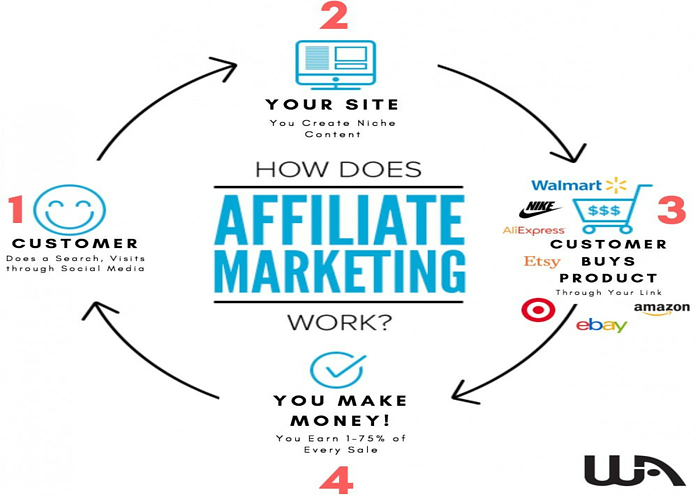Introduction.
In the world of science, whether it is human sciences or natural sciences, you will normally find special words or expressions (jargon) used by the profession or group that are difficult for others to understand. The same applies to Affiliate marketing. To understand the field you are working in, you must give substance to the jargon used. That is the only way to visualise, understand and get a handle on it.
It also helps a lot to know how affiliate marketing has evolved since its humble beginnings in the late 1990s
Have a look at this diagram to help you visualise Affiliate Marketing

In Making Sense of Affiliate Marketing, let me list the special words, terminology and expressions that people use in this field and then give substance to it as we roll along.
- Affiliate Marketing
- Online business model
- Marketing Strategy
- Digital marketing
- Third-party publisher/The Affiliate
- Merchant
- Affiliate network
- Customer
- Platform
- Affiliate link
- Audience
- Niche
- Blogging
- Content
- Website
- Tracking Technology
- Clicks
- Online money making
- AI Artificial intelligence
- Campaigns
- Conversion
- Commissions
- Affiliate models
- Machine learning
- Influencers
- Diversification of Affiliate Models
- PPC (Pay-Per-Click)
- PPL (Pay-Per-Lead)
- PPS (Pay-Per-Sale)
Understanding the Basics of Affiliate Marketing
- Definition of affiliate marketing and how it works
Affiliate marketing is a type of digital marketing in which a third-party publisher, called an affiliate, promotes a merchant’s products or services and earns a commission for each sale or lead generated through their referral link. The merchant benefits from increased exposure and sales, while the affiliate benefits from passive income.
Affiliate marketing involves four main actors: the affiliate, the merchant, the affiliate network, and the customer. The Affiliate Network – acts as an intermediary between the affiliate and the merchant, providing tools, tracking, and payment services. The customer is the end-user who purchases the product or service through the affiliate’s link.
To start affiliate marketing, you need to have a platform such as a website, blog, YouTube channel, or social media account, where you can share your affiliate links. You also need to join an affiliate program or network that matches your niche and audience. Some popular affiliate programs are Amazon Associates, ShareASale, ClickBank, and CJ Affiliate.
You should choose products or services that are relevant, useful, and valuable to your audience, and create high-quality content that showcases the benefits and features of those products or services. You should also disclose that you are using affiliate links and follow the ethical and legal guidelines of affiliate marketing.
Affiliate marketing can be a lucrative and rewarding way to make money online, but it requires hard work, dedication, and patience. You should also keep up with the latest trends and best practices of affiliate marketing, such as using artificial intelligence and cloud software to collect and analyse data, optimize your campaigns, and improve your conversions see what Wealthy Affiliate have in store for you, especially with their new Hub system they put in place,
- The evolution of affiliate marketing over the years
Affiliate marketing has undergone a remarkable journey of evolution since its inception. Over the years, this marketing strategy has transformed and adapted to the changing digital landscape, becoming an essential component of many businesses’ marketing strategies. From humble beginnings to a multi-billion-dollar industry, let’s explore the fascinating evolution of affiliate marketing from the past to the present.
- Origins in the Dotcom Era (Late 1990s): Affiliate marketing’s roots can be traced back to the late 1990s when the concept emerged alongside the rapid growth of e-commerce and the dotcom boom. Amazon was one of the pioneers, launching its Associate Program in 1996, allowing website owners to earn commissions by referring customers to Amazon’s products. This marked the beginning of a new era in online marketing, where businesses realised the potential of leveraging partners to drive sales.
- Rise of Niche Blogging and Content Marketing (Early 2000s): The early 2000s witnessed the rise of niche blogging and content-focused websites. Affiliates started creating valuable content to attract specific audiences, positioning themselves as experts in their chosen niches. This period saw the birth of “mommy bloggers,” tech reviewers, and lifestyle influencers, who monetised their blogs by integrating affiliate links seamlessly into their content. This marked a shift from direct promotion to providing genuine value to the audience.
- Advent of Affiliate Networks and Tracking Technology (Mid to Late 2000s): The mid-2000s brought about significant advancements in tracking technology and the rise of affiliate network platforms that act as intermediaries between affiliates and businesses. These platforms provided a centralized space for affiliates to discover various products and services to promote. Additionally, tracking technology became more sophisticated, enabling accurate measurement of clicks, conversions, and commissions, fostering trust between affiliates and merchants.
- Era of Influencers and Diversification (2010s): The 2010s marked the era of social media dominance and the emergence of influencers. Affiliates expanded their strategies beyond traditional blogging, venturing into platforms like YouTube, 8Instagram, and later TikTok. Influencers leveraged their large followings to endorse products authentically, often blurring the lines between organic content and promotions. This decade also saw diversification in affiliate models, including pay-per-click (PPC), pay-per-lead (PPL), and even the development of browser extensions that simplified affiliate link integration.
- Data-Driven Insights and Performance Marketing (Present): Today, affiliate marketing has become a data-driven industry, with businesses leveraging insights to optimize their campaigns. Performance marketing, which focuses on driving specific actions, such as clicks, leads, or sales, has become the norm. Additionally, the rise of artificial intelligence and machine learning has enabled businesses to automate their affiliate marketing efforts, making it easier to scale and optimize campaigns.
- Roles within affiliate marketing: merchants, affiliates, and customers
In affiliate marketing, there are three primary roles: merchants, affiliates, and customers. Merchants are the companies that sell products or services. Affiliates are individuals or companies that promote the merchant’s products or services on their website or social media platforms. Customers are the people who purchase the products or services from the merchant through the affiliate’s referral link. The affiliate earns a commission for each sale made through their referral link.
- Types of affiliate marketing programs: pay-per-click, pay-per-sale, and pay-per-lead
Affiliate marketing programs are arrangements where a business pays another business or influencer a commission for sending traffic and/or sales their way. There are different types of affiliate marketing programs based on how the commission is calculated and paid. Here are the three types you mentioned:
- Pay-per-click (PPC): This type of program pays the affiliate a fixed amount for each click that is generated from their referral link or promotional efforts. The click does not have to result in a sale or a lead for the affiliate to earn money. This is a low-risk model for the affiliate, but a high-risk model for the merchant, as they have to pay for clicks that may not convert.
- Pay-per-sale (PPS): This type of program pays the affiliate a percentage of the sale price or a fixed amount for each sale that is generated from their referral link or promotional efforts. The sale has to be completed and confirmed for the affiliate to earn money. This is a high-risk model for the affiliate, but a low-risk model for the merchant, as they only pay for sales that are generated.
- Pay-per-lead (PPL): This type of program pays the affiliate a fixed amount for each lead that is generated from their referral link or promotional efforts. The lead is usually a potential customer who fills out a form, signs up for a trial, or performs some other action that indicates interest in the merchant’s product or service. The lead does not have to result in a sale for the affiliate to earn money. This is a medium-risk model for both the affiliate and the merchant, as they share the responsibility of converting the lead into a sale.
- Advantages of affiliate marketing for businesses and marketers
Affiliate marketing is a form of online marketing that involves a partnership between a business and one or more affiliates. The affiliates promote the business’s products or services to their audience and earn a commission for each sale or lead they generate. Affiliate marketing has many advantages for both businesses and marketers, such as:
- Cost-effectiveness: Businesses only pay for the results they get, such as sales, leads, or website visits. This reduces the risk of wasting money on ineffective advertising campaigns. Marketers can start promoting products or services with little or no upfront investment, as they do not need to create or own the products they sell.
- Global reach: Businesses can expand their market to new regions and countries by partnering with affiliates who have a diverse and loyal following. Marketers can tap into a large and varied pool of products or services that suit their niche and audience preferences.
- 24/7 marketing: Businesses can benefit from the constant exposure and visibility that affiliates provide through their online platforms, such as blogs, social media, email newsletters, or websites. Marketers can earn passive income by creating evergreen content that attracts and converts customers at any time of the day or night.
- Reputation boost: Businesses can enhance their brand image and credibility by working with reputable and influential affiliates who can endorse their products or services to their audience. Marketers can build their reputation and authority by providing valuable and honest information and reviews to their audience.
- Additional income streams: Businesses can diversify their revenue sources by offering different types of products or services that appeal to different segments of customers. Marketers can increase their earning potential by promoting multiple products or services from different businesses that are relevant and complementary to their niche.
If you want to learn more about affiliate marketing and its benefits, read what Kyle had to say —
Strategies for Success in Affiliate Marketing
Choosing the right affiliate products and services to promote is an important decision for any affiliate marketer. Here are some tips to help you find the best products for your niche and audience:
- Understand your audience: You need to know what your audience is interested in, what problems they have, and what solutions they are looking for. This will help you select products that are relevant, useful, and valuable to them.
- Use high-quality products: You want to promote products that are of high quality, have a good reputation, and offer a great customer experience. You can do this by researching the product, reading reviews, testing it yourself, or asking for feedback from other affiliates or customers.
- Promote products that fit your niche: You need to choose products that are related to your niche and match your content and tone. For example, if you have a blog about fitness, you can promote fitness equipment, supplements, or online courses. Avoid promoting products that are unrelated or inconsistent with your niche, as this can confuse your audience and hurt your credibility.
- Consider commission rates: You want to earn a fair and attractive commission for each sale you make. You can compare different affiliate programs and products based on their commission rates, cookie duration, payment methods, and other terms and conditions. You can also look for products that offer recurring commissions, upsells, or bonuses to increase your earnings.
- Search for programs that offer conversion data: You can use conversion data to evaluate how well a product or a sales funnel performs. Conversion data can include metrics such as average order value, conversion rate, earnings per click, refund rate, and customer lifetime value. You can use this data to optimize your campaigns, test different products, and improve your return on investment.
To help you with this, visit Wealthy Affiliate’s network/platform:
https://www.wealthyaffiliate.com?a_aid=1b64ad8e
Navigating Challenges
Common obstacles faced by new affiliate marketers
- Choosing a comfortable niche: Finding a niche that suits your interests, skills, and market demand is not easy. It would be best if you did some research and analysis to identify the best niche for you. A good niche should have enough potential customers, low competition, and high commissions. You should also be passionate and knowledgeable about the niche so that you can create engaging and useful content for your audience.
- Confusing codes: If you are not familiar with HTML, CSS, or other web development languages, you may find it hard to customize your website, insert affiliate links, or track your performance. You may need to learn some basic coding skills or use tools and plugins that can simplify the process for you. You should also test your links and codes regularly to make sure they are working properly and not affecting your site speed or user experience OR you can join Wealthy Affiliate to guide you and help you with this.
- Motivation: Affiliate marketing is not a get-rich-quick scheme. It takes time, effort, and patience to build a successful online business. You may face periods of low traffic, sales, or income, especially in the beginning. You may also encounter rejections, negative feedback, or technical issues. You need to stay motivated and focused on your goals, and not give up easily. You should also celebrate your small wins and achievements, and learn from your mistakes and failures.
- Attracting the right traffic: Getting visitors to your website is not enough. You need to attract the right kind of traffic, that is, people who are interested in your niche, your products, and your offers. You need to use effective marketing strategies, such as SEO, social media, email marketing, or paid advertising, to reach your target audience and drive them to your site. You should also provide valuable and relevant content that can solve their problems, answer their questions, or satisfy their needs.
- Low sales numbers: Even if you have a lot of traffic, you may not make many sales or commissions. This could be due to various reasons, such as low-quality products, poor conversion rates, high refund rates, or low customer loyalty. You need to choose the best products and services to promote, that are reliable, reputable, and match your audience’s preferences. You should also optimise your website, your content, and your calls to action, to increase your conversion rates and reduce your bounce rates. You should also build trust and rapport with your audience, and follow up with them regularly, to encourage repeat purchases and referrals.

 (That’s how it looks like when you start figuring out how to set up an online business… )
(That’s how it looks like when you start figuring out how to set up an online business… )